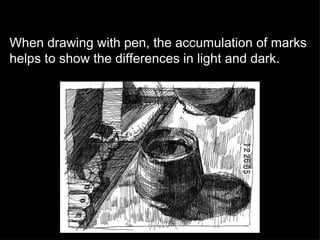Recommended
More Related Content
What's hot
What's hot (20)
Viewers also liked
Viewers also liked (19)
Debora Alanna: Drawings from 2011-2012 - pen on paper 

Debora Alanna: Drawings from 2011-2012 - pen on paper
Similar to Ink
Similar to Ink (20)
More from cjoyce104
More from cjoyce104 (20)
Ink
- 1. When drawing with pen, the accumulation of marks helps to show the differences in light and dark.
- 2. Hatching is the use of lines to create shading. The shadow is darker where the lines are closer together. The tone appears lighter when the lines are farther apart.
- 3. When adding value with pen, you will be making a series of marks. In this image, the building has been shaded using hatching.
- 4. Hatching has been used to great effect in this image. Lines closer together provide the dark shadows on the coat. They are also heavier, thicker lines. In the detail of the collar, face and hands thinner lines are used farther apart to achieve a lighter tone.
- 7. Notice the direction of the hatching in this image. Not all the lines are going in the same direction. This is helping to show the folds of fabric in the cloak.
- 8. This drawing uses “cross hatching” to achieve value. Cross hatching is the the use of hatched lines overlayed at an angle- the lines cross to result in shading.
- 10. Each of these are examples of cross hatching. Notice the different effects when you use longer or shorter lines or evenly spaced verses more random lines. It is possible to use all these techniques in one drawing.
- 12. Scumbling, often called the 'brillo pad' technique, uses layers of small scribbled marks to build up value and texture. Varying the direction and shape adds more interest than a simple circular scribble.
- 13. This drawing uses scumbling to show texture and value. This method works very well to describe the surface of the walls.
- 15. A final way to add value and texture with pen is to use stippling. Stippling uses tiny dots to create value. The closer together the dots, the darker the tone. Larger dots create a denser tonal value more quickly, but can look coarse.
- 16. This image uses almost all the pen techniques for finding value and shadow.
- 17. Our first in-class assignment is to create three nine step value scales using pen. One scale will use hatching One scale will use cross hatching The third scale is the texture of your choice-- try something interesting.
